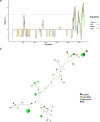Whole-genome analysis of Malawian Plasmodium falciparum isolates identifies possible targets of allele-specific immunity to clinical malaria
- PMID: 34033654
- PMCID: PMC8184011
- DOI: 10.1371/journal.pgen.1009576
Whole-genome analysis of Malawian Plasmodium falciparum isolates identifies possible targets of allele-specific immunity to clinical malaria
Abstract
Individuals acquire immunity to clinical malaria after repeated Plasmodium falciparum infections. Immunity to disease is thought to reflect the acquisition of a repertoire of responses to multiple alleles in diverse parasite antigens. In previous studies, we identified polymorphic sites within individual antigens that are associated with parasite immune evasion by examining antigen allele dynamics in individuals followed longitudinally. Here we expand this approach by analyzing genome-wide polymorphisms using whole genome sequence data from 140 parasite isolates representing malaria cases from a longitudinal study in Malawi and identify 25 genes that encode possible targets of naturally acquired immunity that should be validated immunologically and further characterized for their potential as vaccine candidates.
Conflict of interest statement
The authors have declared that no competing interests exist.
Figures




References
-
- WHO | World malaria report 2018 [Internet]. WHO. [cited 2019 May 30]. Available from: http://www.who.int/malaria/publications/world-malaria-report-2018/report...
Publication types
MeSH terms
Grants and funding
LinkOut - more resources
Full Text Sources
Other Literature Sources

